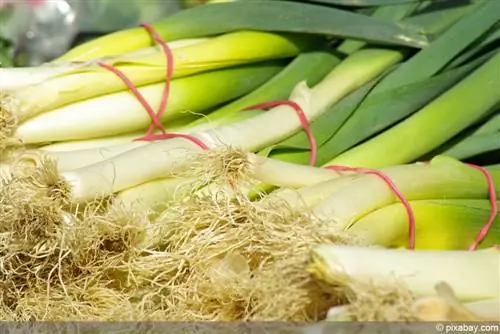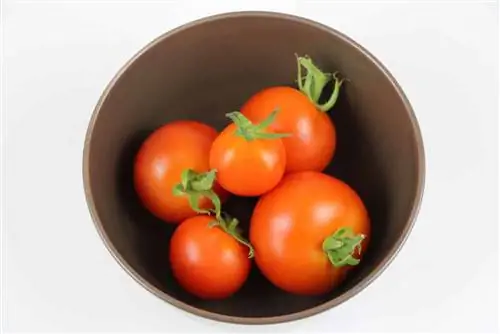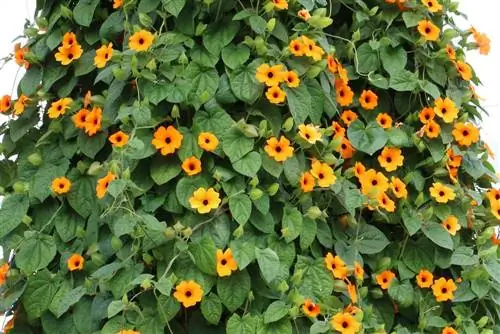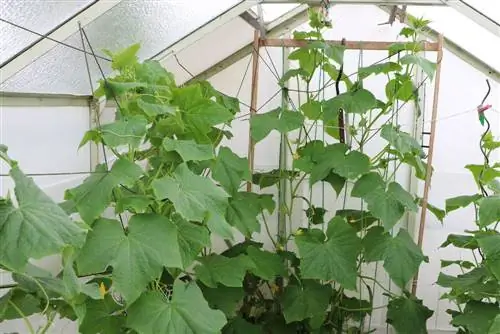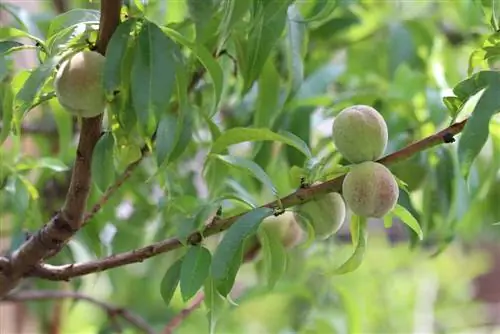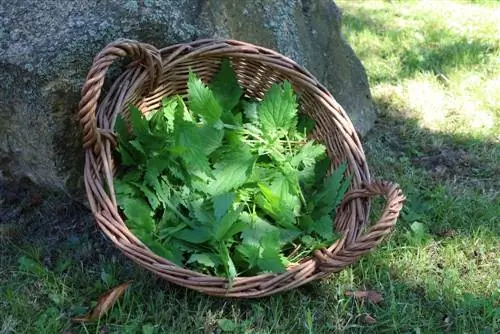- Author admin [email protected].
- Public 2023-12-17 03:39.
- Last modified 2025-06-01 06:48.
Depending on the planting time and harvest time, there are summer leeks, autumn leeks and winter leeks. But all leek varieties (Allium porrum) are amaryllis plants that do not produce bulbs. At least not in its cultivated form as garden leeks. This cultivated form of field garlic is herbaceous, biennial and can grow up to 80 centimeters long. The green leek stalks are said to have been on the menu even among the ancient Egyptians. Before you decide to grow it, it doesn't hurt to know how much care is required.
Sowing or young plants
This is the question that every hobby gardener will ask themselves first: Do I grow the leeks myself from seeds or, when the time comes, do I buy young plants that have already been grown? Without a doubt, it takes less effort to start planting the young, thin leek plants in mid-March.
Sowing
Anyone who has decided on the more complex sowing option is faced with two further decisions:
- prefer the seeds or sow them directly
- desired harvest time (summer leeks are brought forward from January)
In any case, it is advisable to prefer leeks. By growing in small peat pots you can save yourself the trouble of pricking out. In addition, just because of the timing, it is absolutely necessary to bring the summer leeks forward in January and February. Plants grown earlier are more resistant to diseases and pests in later stages.
Advance
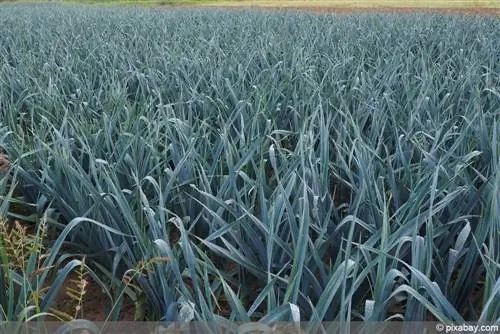
Small cultivation pots or soil press pots are perfect for growing. The latter can simply be placed in the bed later without damaging the fine roots.
- Seeds germinate faster if they are soaked in a valerian broth overnight
- Growing pots approx. five centimeters in diameter
- Planting soil or a mixture of peat and sand
- Press one or two seeds each, a good centimeter deep, into the soil
- pour on
- optimum temperature at least 14°C and bright
- Germination time approx. 14 days
- If the seedlings are approx. five centimeters tall, they can go into the bed
Tip:
If you want to harvest in August, you have to plant your leeks in January or February; for winter leeks, sowing them in early June is enough.
Planting
No matter whether they are young plants from the weekly market or leek plants you have grown yourself, from mid-May they can be planted outdoors, either in planting holes or planting trenches.
- Distance between the individual plants 15 to 30 centimeters
- Row spacing 40 to 60 centimeters
- either place in grooves approx. 15 centimeters deep
- or in individual planting holes
- up to half depth into the holes, insert grooves
- Plants must be absolutely vertical
- water well, slurry in, for optimal stability
- no soil should fall into the leaf axils
For planting in planting holes, the soil in the bed should be well loosened. Holes are then made into the earth using a piece of planting wood. The early plants can be placed in the holes either with a peat pot or with all the soil from a growing pot. When growing leeks in trenches, the soil in the bed must also be loosened up well. The excavated material can be left between the rows of plants. This makes it easy to pile up the leeks later.
Location and soil
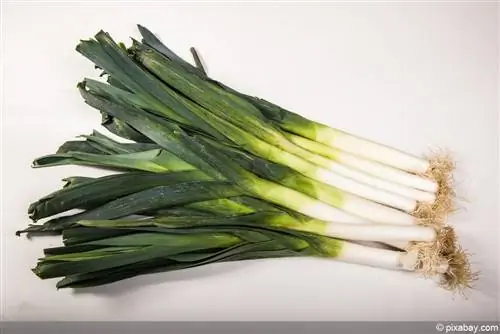
Sunny to partially shaded and still moist, that's how the leek likes it best. Leeks are quite tough when it comes to temperatures. But the more protected it is grown from wind and cold, the fewer protective measures you have to take later with winter leeks. A cover with fleece or brushwood can protect the winter leek from early, hard frosts.
While onions are medium-feeders, the leeks tend to be heavy-feeders. Leeks therefore need generous amounts of fertilizer. This means that the soil should be thoroughly loosened and mixed with organic fertilizer or mature compost before cultivation outdoors. Another option is to generously mix the soil with nettle manure or grass clippings. Coarse clods of earth should be crushed. This preparation of the soil should ideally be carried out in January or February.
Tip:
If you want to prepare the soil in autumn: pre-sowing with mustard or lupine is an ideal green fertilizer for the leeks next spring.
Neighbors
Salads are ideal as an intermediate crop, as long as the leeks have not yet taken off. Good neighbors are:
- Celery
- Kohlrabi
- Cucumber
- cabbage
- Marjoram
- Endive
- cabbage
- Carrots
Bush beans, runner beans, beetroot and peas are not likely to be good neighbors for leeks. If you add wormwood, oregano, carrots or radishes to the leek, you will also be driving away the leek moth. Tagetes (marigolds) repel whiteflies. On the other hand, leeks placed between the strawberries can prevent mold diseases in the strawberries.
Care
In addition to fertilizing and regular watering, you should rake the rows more often, loosen them up and remove weeds. Towards the end of the season you can push the soil from the furrows between the rows towards the leek stem. It's best to only reach under the leaf axils, so you can keep the rings relatively clean of the soil.
Fertilize

As a heavy feeder, you can give the leek a good start right from the start if you mix the soil generously with compost beforehand. If green manure has been pre-sown, you can fold it under and still incorporate compost. After a month you start with regular fertilizer applications, every two weeks. Either you water with nettle manure or sprinkle organic fertilizer on the soil. The fertilizer can be emphasized with nitrogen.
Pouring
In the main growing season, the leek needs a lot of water, especially in dry weather periods it needs to be watered daily. Otherwise, the right size can be found. The leek must never dry out completely and constant moisture or even waterlogging must be avoided.
Harvest
Leeks require a relatively long ripening period; this only happens five to six months after planting. The rods then have a diameter of approximately three centimeters. The summer and autumn leeks can be harvested gradually, but should be harvested before the first frosts. Winter leeks are fairly hardy and can be harvested all winter long on frost-free days. The harvest times of the leek varieties:
- Summer leek July, August
- Autumn leek September - December
- Winter leek December - May
If the stalks are simply cut off above the root and the ambient temperatures are still warm enough, new, slightly thinner stalks can form again. Otherwise, to harvest the whole stalks, carefully go down to the roots with a rake and lever them out of the soil a little. The best time for this is early in the morning. Then the Stanges should rest like this for a while, so they will lose some more nitrite. In the afternoon you can then pull them completely out of the ground.
Propagate
If you want to use your own leeks as a basis for growing again, you have two options. You can wait until flowers and then seeds have formed on some of the stalks that have not been harvested in the spring. Or, you cut off the inflorescences and then bulbs form. If you dig these up, you can use them individually for new leeks.
For propagation, choose a few strong plants that you leave standing. Beautiful flower balls will emerge next summer. If they have dried out, they can be cut off and the seeds knocked out. If the leek starts to sprout in winter due to the cold stimulus, then these flowers are not suitable for collecting seeds.
Varieties
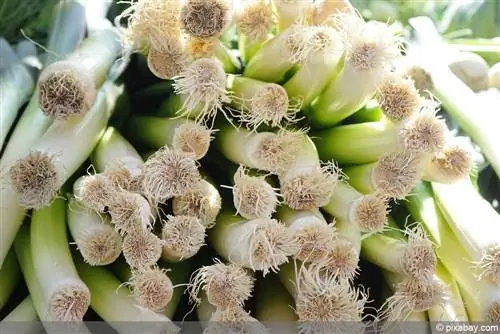
The following are some vigorous and robust leek varieties for every harvest season.
Summer leek
- ‘Albana’
- ‘Alma’
- ‘Bavaria’
- ‘Tropia’
Autumn leek
- ‘Ducal’
- ‘Elephant’
- ‘Gino’
- ‘Autumn Giants’
- ‘Autumn Giant Hannibal’
- ‘Blue-Green Autumn’
- ‘Easton’
- ‘Belton’
Winter leek
- ‘Blue-Green Winter’
- ‘Natan’
- ‘Genita’
- ‘Fahrenheit’
- ‘Freezo’
- ‘D’hiver de Saint-Victor’
- ‘Pluston’
- 'Siegfried'
Diseases and pests
If you use reasonably resistant seeds and robust varieties, you won't have much trouble with diseases and pests. Leek moths, leek leaf miners, onion flies, nematodes and leek rust can be dangerous. To protect the leeks from flying pests, fine-mesh nets are often stretched over the rows.
However, growing a mixed crop is also good protection. Carrots, wormwood and tergetes in particular are protective neighbors. Too much humidity and too much nitrogen fertilizer promote the spread of fungal diseases such as leek rust. Especially with the close-meshed vegetable protection nets, the plants may not be ventilated enough.
Conclusion
All in all, growing leeks seems quite feasible, despite some special features. Basically, it is more convenient and easier to start with young plants. The risk of pests and diseases can be minimized somewhat with a few suitable partners at your side. If you are planning larger quantities, you should also think about storage. For example, winter leeks can remain in the ground well into the next year. The summer and fall varieties should be harvested before the first frost. However, leeks can also be frozen very well if blanched briefly.

